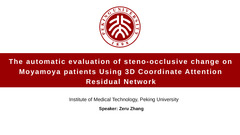Moyamoya is a specific chronic cerebrovascular occlusive disorder that is characterized by progressive bilateral stenosis of the terminal portion of the internal carotid artery and its main branches. The surgical procedure of intracranial and extracranial vascular reconstruction can reduce symptoms and lower the risk of complication. The surgery threshold depends on the preoperative brain vascular imaging evaluation whose accuracy is greatly influenced by the radiologist. This study aims to achieve a preoperative deep learning-based evaluation of moyamoya patients by distinguishing between stenosis and normal MCA. The deep learning model with fine-tuning was developed using 3D Coordinate Attention Residual Networks (CA-ResNet). A total of 50 patients with moyamoya disease and 50 normal controls were enrolled. The preoperative Time-of-Flight Magnetic Resonance Angiography (TOF-MRA) was performed in all patients. For each patient, a region with 60mm thickness was extracted based on the reference points on MCA. The 3D CA-ResNet was trained based on sub-volumes

patches from selected regions and was tested using patch-based and patient-based methods. The performance of 3D CA-ResNet was compared with those of conventional networks including 3D ResNet and 3D Visual Geometry Group (VGG), where the Area Under the Curve (AUC) and classification accuracy were used as evaluation indicators. The final experiments showed the expected results in distinguishing between patients with moyamoya disease and normal controls. Specifically, the values of AUC and accuracy were 0.94 and 0.89 for patch-based and only one patient was misdiagnosed for patient-based testing in 3D CA-ResNet, respectively. In addition, the AUC value of 3D CA-ResNet was higher than the counterparts of conventional 3D ResNet or 3D VGG for patch-based testing (3D CA-ResNet: 0.94 vs. 3D ResNet: 0.85; 3D CA-ResNet: 0.94 vs. 3D VGG: 0.84). Besides, Gradient-weighted Class Activation Mapping based on heatmap was used to provide visual clues related to vascular stenosis location on MCA. The results indicated that all the three models above are able to differentially diagnose moyamoya disease from clinical TOF-MRA data, and the 3D CA-ResNet outperforms 3D ResNet and 3D VGG in evaluating vascular steno-occlusive change on moyamoya patients.


Comment submit